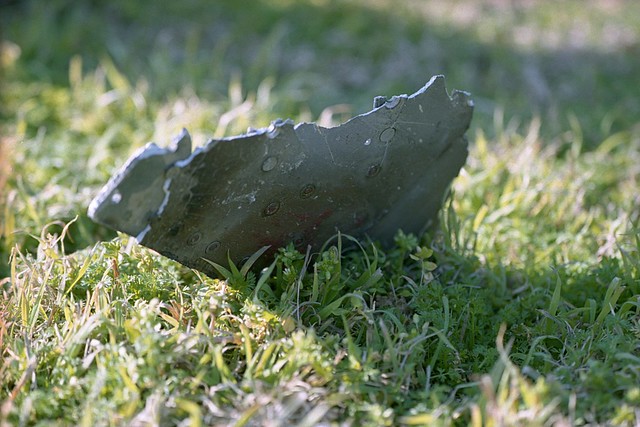On Sunday, Susan and I decided to go hunting for shuttle debris. I had been inspired by a fellow-DPRG member, Eric Yundt, who reported having seen a tile fragment less than an hour from Dallas in Rice, Texas. We picked up a paper and looked for any references to confirmed debris sightings but most were too vague. And most of the debris hit in Nacogdoches and Hemphill which were too far away to make the round trip in one day.
So we decided to head for Rice, Texas. We easily found the site Eric saw on the I-45 frontage road near the Rice High School. The debris was marked by orange traffic cones and yellow crime scene tape. A local policeman was guarding it. Sometime after Eric was there on Saturday, orders were apparently issued to cover the debris. In most cases, this meant a 5 gallon plastic bucket had been placed over the item.
The police officer in Rice was not allowing anyone close to the debris and would not remove the plastic cover so we could see it. He also was not forthcoming about any other debris locations. Since the newspaper hadn’t been much help in pinning down exact locations either, we were momentarily afraid we’d have to give up right there. But I noticed a van from local TV station KTVT and walked over to talk with one of the technicians. He said he’d been in Kerens a little earlier. There was a lot of debris scattered around there and the Kerens officials were much friendlier, too.
A half hour later, we arrived in Kerens. We shortly arrived at an intersection with a police car and a whole lot of orange cones and crime scene tape. On one side of the street was a large dirt field with dozens of orange cones scattered through it. The state trouper guarding this site said we couldn’t go into the field because they weren’t sure that all the debris had been identified yet. However, on the other side of the street, were two pieces we could look at. He offered to remove the plastic containers so we could see and photograph them.
The first was a partial heat shield tile. The serial number was still visible but the tile was pretty badly damaged. The second piece was a completely intact tile. Small portions of the black, glass-like exterior had been damaged and the white color of interior could be seen. While we were looking at these, a couple of locals came by and started talking about debris that had landed in their yards or at other locations nearby. Most of it seemed to be tiles. However, they said they knew of one aluminium fragment that hit between two nearby churches. We got directions and headed that way.
We found a local policeman sitting in his car near the usual barrier of traffic cones and crime scene tape with a plastic can in the center. Like the state trouper, he happily removed the can so I could take some photos. This piece was a triangular shard of metal. One side had been painted and was now badly charred. The other side was bare metal and had an assortment of broken fasteners on it. The policeman said he’d seen a lot of the debris land. His description was not the view of the white contrails moving across the sky but of white contrails coming down out of the sky towards their town. Considering how much debris there was, it’s amazing no one was injured.
By this time, we decided to start for home again. There was more debris in Kerens but it was all very similar. Mostly tile fragments and a few bits of metal so it didn’t seem worth more time. Have a look at the photos if you’re interested.


